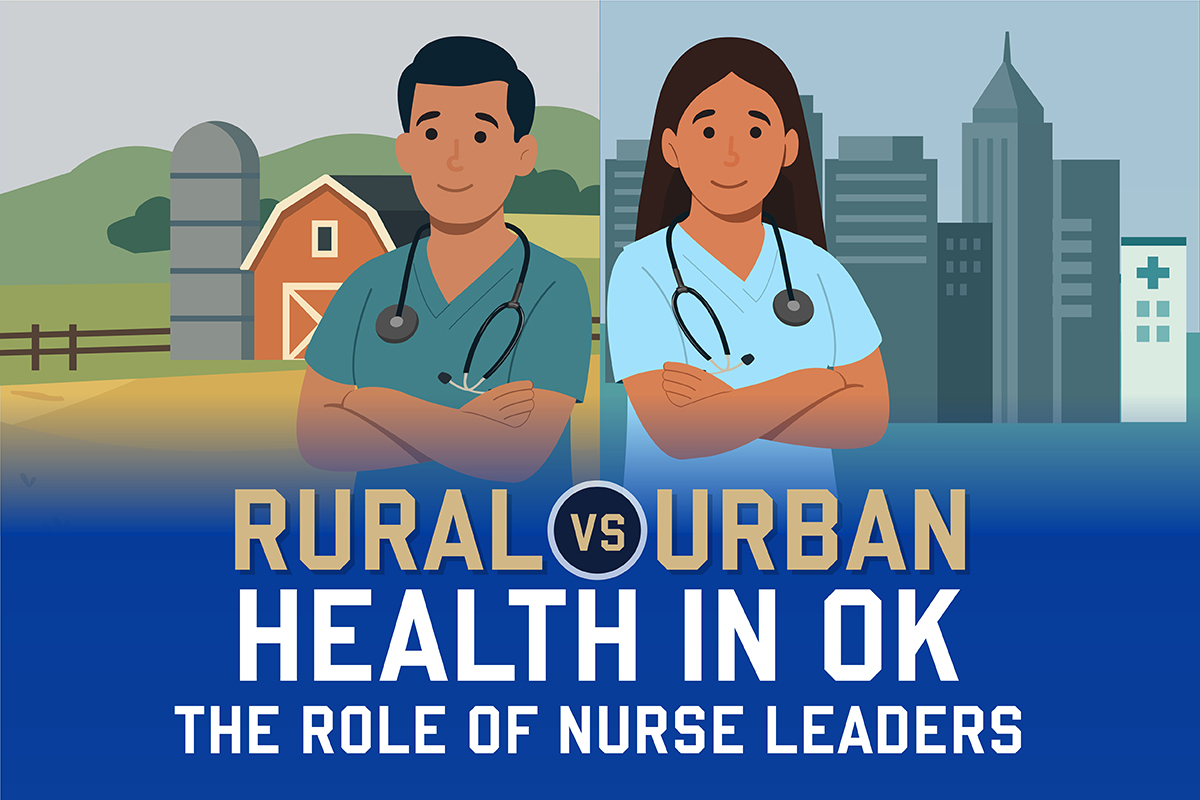Rural vs. Urban Health in OK: The Role of Nurse Leaders
Written by:
University of Tulsa
• Oct 29, 2025

While one in five Americans live in a rural area, that number rises to nearly one in three in Oklahoma. Rural health care providers, including nurse leaders, can help close the gap between rural vs. urban health outcomes. National and Oklahoma data on rural and urban health show where nurse leaders can have the greatest impact.
To learn more, check out the infographic created by the University of Tulsa’s Nursing Programs.

Rural vs. Urban Health Disparities
Across the country, Americans in rural areas have shorter life expectancy and worse health outcomes. They also exhibit worse numbers on social determinants of health, such as poverty rates and education level. Breaking down the data on rural and urban health disparities reveals the challenges that nurse leaders face.
One in five Americans live in a rural area, according to the CDC. In 2019, urban Americans had a life expectancy of 78.32, while rural Americans had a life expectancy of 76.46.
Comparing Rural vs. Urban Health Disparities
Demographically, rural Americans are older than urban Americans, with those 65 and older making up 19.2% of rural populations compared to 15.7% of urban populations, according to the Federal Housing Finance Agency. Rural Americans also report higher rates of cigarette smoking and obesity, based on research from the CDC and the Journal of the American Medical Association.
The gap between rural and urban health outcomes extends beyond life expectancy. According to the CDC, rural Americans are at a higher risk for the top five leading causes of death: heart disease, cancer, unintentional injury, respiratory disease, and stroke.
Rural adults are at increasing risk of dying of natural causes when compared to urban adults, and this health disparity has grown worse over time. In 1999, rural adults had a 6% higher death rate than urban adults. Twenty years later, rural adults had a 43% higher death rate, according to the USDA.
Comparing Rural vs. Urban Health Care
How does health care compare in rural vs. urban areas? Rural Americans have less access to health care. The Oklahoma Farm Bureau reports that 128 rural hospitals have closed in the past decade across the country. While metro counties report 36 physicians per 10,000 people, nonmetro counties have just 13 physicians per 10,000 people, according to the Rural Health Information Hub.
Rural Americans also have higher poverty rates and lower health insurance rates. While 11.9% of urban Americans live below the poverty line, 15.4% of rural Americans live in poverty, based on 2019 USDA data. That helps explain the gap in health insurance coverage, where 12.6% of rural Americans are uninsured compared to 10.9% of urban Americans, according to 2023 HHS data.
Oklahoma Rural vs. Urban Health Data
Oklahoma has a large rural population. Rural areas report less access to health care, worse health outcomes, and higher poverty rates than Oklahoma’s urban areas.
Rural Oklahoma was home to 32.4% of the state’s population in 2023, based on Rural Health Information Hub data. Nationally, 20% of Americans live in rural areas according to 2020 Census data.
Comparing Oklahoma Rural vs. Urban Health Disparities
The data shows a stark difference in rural vs. urban health disparities in Oklahoma. Rural Oklahomans have a 9.6% death rate compared with 8.78% in urban parts of the state, based on 2023 Oklahoma Farm Bureau data. And 15.7% of Oklahomans in non-metro counties don’t have health insurance, compared with 13.7% in the state’s metro counties.
According to Rural Health Information Hub data, rural Oklahomans also have a higher poverty rate – 18.5% compared with 14.5% – and a lower median household income of $54,000 in rural areas compared with $68,000 in urban areas.
Oklahoma Rural Health Care
Oklahoma lacks a strong rural health care network. As of 2025, Oklahoma’s rural population is served by 39 critical access hospitals, 4 emergency hospitals, and 141 health clinics, according to Rural Health Information Hub data.
Out of the state’s 77 counties, 64 reported a shortage of providers serving people at or below 200% of the federal poverty level, according to Oklahoma Magazine.
The lack of access particularly harms maternity care. Nationally, 32.6% of counties are defined as maternity care deserts, according to 2022 March of Dimes data. That number reaches 53.2% of Oklahoma counties.
Nurse Leaders and Oklahoma Rural vs. Urban Health
Nurse leaders can help address the health disparities in Oklahoma’s rural vs. urban areas. While they face unique challenges, rural nurse leaders play an important role in providing quality patient care.
Challenges Rural Nurse Leaders Face
Staff shortages, limited growth opportunities, and resource constraints challenge nurse leaders in rural areas.
Rural hospitals are often short-staffed, creating difficult circumstances for nurse leaders. Lower pay compared with urban RN jobs also impacts rural staffing issues. In addition, rural hospitals may offer fewer opportunities for professional development. Nurse leaders can advance their education to move into roles with greater autonomy.
Finally, in rural areas, nurses may face longer times for test results, challenges with patient transfers, and a lack of specialized services. This poses challenges for providing patient care.
Bachelor of Science in Nursing programs teach nurses leadership skills along with clinical expertise. According to the most recent data from the Journal of Professional Nursing, 57.9% of urban nurses have a BSN, while 46.1% of rural nurses have a BSN.
Key Qualities for Rural Nurse Leaders
The most important qualities for rural nurse leaders include adaptability, communication, compassion, and accountability.
Rural nurses may face shortages and unanticipated challenges. The best nurse leaders must be flexible to adapt to changing circumstances. Similarly, nurse leaders with strong communication skills provide better patient care. In addition to communicating with members of the health care team, they also convey medical information to patients and their families.
In rural areas, nurse leaders will more likely interact with older, sicker, and more injured patients. Compassion for the challenges that patients face will help these nurses succeed. When it comes to accountability, nurse leaders set goals for their teams and encourage a culture of engagement and accountability. This can improve patient care outcomes and boost retention.
Meet Rural and Urban Challenges
Understanding the challenges that rural nurse leaders face can help prepare nurses to meet the health care needs of Oklahoma’s rural areas. Nurses who advance their education can also develop the leadership skills needed to improve health outcomes.
Sources
Engage Oklahoma Association, Engage Free Medical Clinics
Federal Housing Finance Agency, “Who Lives In Rural America?”
Journal of Professional Nursing, “Rural-Urban Differences In Educational Attainment Among Registered
Nurses: Implications For Achieving An 80% BSN Workforce”
March of Dimes, “Where You Live Matters: Maternity Care Access In Oklahoma”
National Rural Health Association, “Building Strong Leadership In Rural Health Care”
Oklahoma Farm Bureau, Rural Health Care
Oklahoma Magazine, “Expanding Access, Saving Lives”
PLOS Global Public Health, “Rural-Urban Disparities In Health Outcomes, Clinical Care, Health
Rural Health Information Hub, Physicians Per 10,000 People For Metro And Nonmetro Counties
Rural Health Information Hub, Oklahoma
U.S. Census Bureau, 2020 Census Urban Areas Facts
U.S. Centers for Disease Control and Prevention, About Rural Health
U.S. Centers for Disease Control and Prevention, “Rural–Urban Differences In Overweight And Obesity
Physical Activity, And Food Security Among Children And Adolescents”
U.S. Department of Agriculture, “Rural Poverty & Well-Being”
U.S. Department of Agriculture, “The Nature Of The Rural-Urban Mortality Gap”
U.S. Department of Health and Human Services, “Access To Health Care In Rural America


